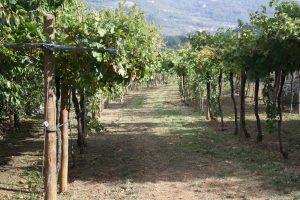Wine is an art form. It’s also an industrial process. And it all starts with farming. The art is something we understand. The second we’ve been taught through books and winery tours, and sort of get. But no matter how much we have read and heard about trellising, soil composition, canopy management and sun angles, we still don’t get it. All we know is that vineyards are pretty.
We like looking at them from a distance. We like getting close up, especially when the vines are heavy with grapes near harvest time. Our photo files are replete with pictures of dangling fruit. and if you are lucky enough to be in Wine Country just before the harvest, you’ll want these pictures, too. And we just like walking through vineyards.
For one thing, you get a sense of the incredible variety in the way grape growers carry out their craft. For example, in Beaujolais, they crop their vines close to the ground, whereas in California they are usually chest high. In Burgundy, they grow their vines quite high, so that two visitors can lose one another if they’re not careful. It’s something like the mazes that some corn farmers erect after their harvest. And in Valpolicella, they grow their grapes so high that the vines are over a visitor’s head.
The vineyard of Quintarelli.Giuseppe in Valpolicella
Then there’s the sense of history you feel in certain vineyards. There’s a little thrill you get knowing that wines have been made from the same produce you see before you, for years and years. That might be only 45 years in Long Island (Castello di Borghese) or 450 years (Chateau Margaux). And if you walk up the hill in Burgundy called the Corton-Charlemagne (where they grow grapes for a Grand Cru white wine) you are standing on ground owned by the Emperor Charlemagne, who lived in the 800’s.
Finally (and please don’t tell), if you’re in the vineyards at harvest time, you can sample a few grapes. You know those grapes you buy in the grocery store? They’re tasteless, sour things compared with wine grapes. The more alcoholic wines are made from sweeter grapes, which have more sugar of course. The grapes of Beaujolais (around 13%) aren’t shabby, but Zinfandels are small and often 14.5% or more and those grapes are super-yummy.
For some reason, the farmers are not wild about hordes of outsiders tromping through their fields. Maybe they just don’t like tourists getting in the way of workers, raising a lot of dust and messing with the grapes. So strolling through the vineyards is not always an activity appreciated by the proprietors. However, in a previous vacation in Burgundy, we picnicked in a different vineyard every day and no one ever came to tell us to leave. It was heaven! In the next issue of Power Tasting, we’ll give you tips on how you can take a walk in a vineyard.

